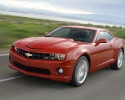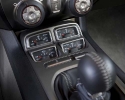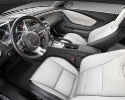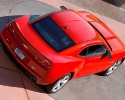2011 Chevrolet Camaro SS Coupe
A few years back, when General Motors launched the Chevy Camaro, it was in the middle of the biggest crisis in its history. In a very poor overall economy, one may have been surprised to see the company rollout such a niche product. The car, which does not exactly fit into the current trend towards eco-friendliness, should have been a slow seller.
But noooo. On the contrary, the Camaro burst out of the gates, with thousands of orders for the car, sight unseen, from people who remembered its spiritual ancestor the 1969 Camaro, and wanted to relive the experience of the iconic performance car that was the height of GM design in the day.
The model that was getting most of the attention and orders was the V8-powered SS, despite the availability of the quite competent 300-horsepower V6 model. It seems that the big American V8 is still the most lusted-after engine, no matter what vehicle it is installed in, and no matter how many times we are told that it is not politically correct to have one.
Now that we have had the chance to drive an SS, in attention-grabbing Rally Yellow, no less, we are not surprised with its popularity. It’s a head-turner for sure, especially if you are enjoying the deep rumble of the 426-hp 6.2L Corvette LS3 engine in a lower gear than you might otherwise want to be in for economy.
And economy isn’t a totally foreign concept in this car, as you can use the massive torque and keep it under 1,500 rpm. However, the sound and fury of a big, pushrod V8 is too hard to resist. Running up through the gears of the beefy six-speed manual is just too much fun, an impression confirmed by a zero-to-100 km/h time in the five-second range. An automatic is available, but it sits behind a different V8, the L99 with less (400) horsepower and cylinder deactivation for even more economy. We say, if you want more economy, get the V6.
In any case, the power is distributed to the rear wheels, which are massive 20×9-inch units, and the big summer performance rubber surrounding them contributes greatly to the Camaro’s handling prowess, as does the independent rear suspension and performance-tuned shocks. Hauling it all down to a stop are four-piston Brembo brakes. The car has serious performance credentials, although its weight and size will probably preclude it being considered as a track day car, for example. But as a street car, the SS will put a smile on your face every time.
Our tester was what GM calls internally the 2SS model, which basically means “loaded” with all the luxury and performance goodies that Chevy can throw at it. One can opt for the “1SS” level, which forgoes some of the luxury touches and keeps the go-fast stuff. Some of the gear you’d be giving up includes upgraded audio and connectivity, leather seats, and the small auxiliary gauges.
There is one aspect of the Camaro which must be mentioned on several levels, and that can be summed up as “interior.” There is a high level of retro design both outside and inside the Camaro, but one must say that the interior got the most attention from the designers in their attempt to emulate the ’69 car. Most of all, the dashboard is very ’69, and that results in a set of gauges which are hard to read and not especially attractive (read: cheap looking), and an odd conglomeration of secondary controls (audio, HVAC) in a small pod in the middle of the dash, making them all a bit difficult to use. Unfortunately, the dashboard is the one part of the car that the driver sees most often, so it is easy to form a negative opinion of it in everyday use, and that is what happened in our case. This is unfortunate, given how much we like the rest of the Camaro’s design.
The rest of the interior is a bit of a mixed bag. The two front seats provide good support and thankfully aren’t as thin and flat as the ’69 originals, while the back seats are, as expected, suitable for smaller folks only. The driver gets the most comfort with the six-way power adjuster, and it is needed if he is tall and the car is equipped with the optional sunroof, as ours was. If you are over six feet tall, you may want to think twice about the need to let the sun shine in. With the low roof and high beltline of the Camaro, sitting in one is already like looking out the slit windows of an armoured personnel carrier; having to slouch and crouch a bit because of even less headroom just exacerbates that impression.
And then, there is the trunk, which is about the size one would expect in a sport coupe. The back seats don’t fold so no help with space there. But making the trunk that much less useful is the small opening, which limits what can be stuffed in there even if it would fit. We are thinking of a large golf bag here.
Okay, enough of the practical stuff. It had to be said, but in the end, the Camaro is not being bought by people who are overly concerned with rear seats and trunk room. It is all about performance and style that appeals to anyone who likes American-style muscle. And if you happen to be old enough to remember the muscle car era when ’69 Camaros, for only one glorious year, were THE pony car to have, all the better.
The Camaro’s value proposition makes it appealing on more than just an emotional level. The base price of a Camaro with entry level “1SS” trim is $37,195, and the 2SS starts at $42,035. We hesitate to use the word “bargain” for a $40,000 car; however the Camaro has the drivetrain of a Corvette and virtually the same performance. Add in all the heritage of the Camaro nameplate, which comes a close second to Corvette in the history of the Chevrolet brand. Factor in arguably more practicality (including that the big V8 will run on regular gasoline) – all for half the price of a Corvette. The Camaro also costs much less than some vaunted imported competition that would disappear astern of the Camaro in a speed contest.
So, if you can get beyond the interior quibbles, the Camaro is one serious performance car, an artful tribute to an iconic model, and a good value, too. Now we understand why so many people pulled out their chequebooks as soon as GM started taking orders for them, and are happy to be so politically incorrect.
Copyright © Auto Reviews Online 2016 | Privacy & Terms of Use | info@autoreviewsonline.com | Website by Brolly Media





